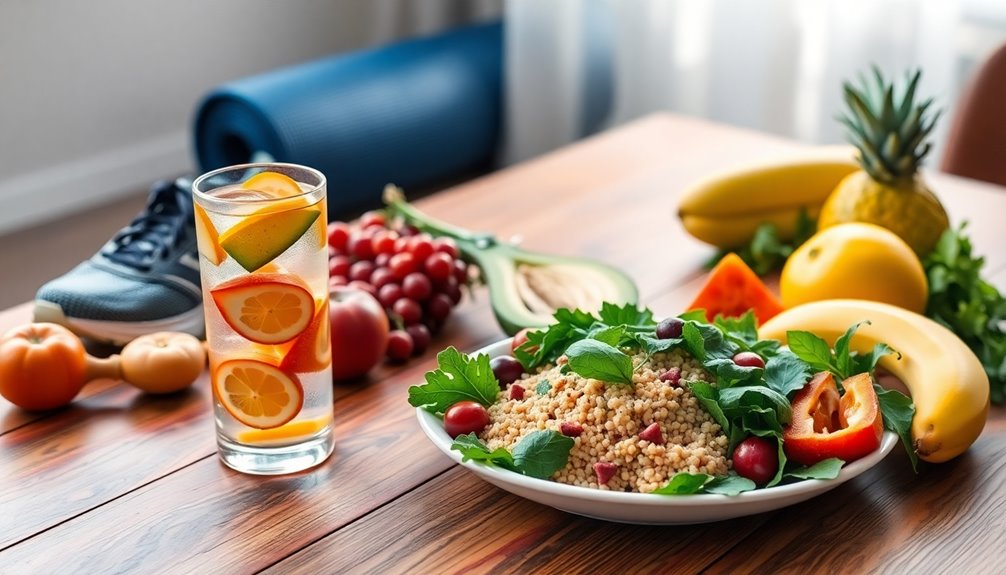To balance your diet and fitness goals, start by setting realistic, attainable objectives. Reflect on your current habits and break your goals into manageable steps for steady motivation. Meal planning is crucial; make sure your meals are nutrient-dense and prepare healthy snacks in advance. Remember to stay hydrated—aim for 8-10 cups of water daily and include water-rich foods in your diet. Choose workouts you enjoy, as this keeps you engaged over time. Finally, track your progress with a food diary or fitness apps to stay accountable. There's much more to discover about fine-tuning this balance for lasting success.
Key Takeaways
- Set practical and attainable goals to keep motivation high and ensure steady progress in both diet and fitness.
- Plan balanced meals and prepare healthy snacks to avoid unhealthy choices and maintain energy levels throughout the day.
- Stay hydrated by drinking 8-10 cups of water daily and incorporating water-rich foods into your diet for overall health.
- Choose enjoyable workouts and mix up routines to sustain long-term fitness success and keep motivation levels high.
- Track your progress with a food diary and fitness apps to identify patterns and celebrate small achievements along the way.
Set Realistic Goals

Setting practical objectives is crucial for achieving success in your diet and fitness journey. When you establish attainable targets, you're more likely to stay motivated and committed. Start by evaluating your current eating habits and fitness levels. This honest assessment helps you pinpoint specific areas to enhance and allows for effective goal setting.
Incorporate mindful eating into your routine. This entails being fully present while you eat, relishing each bite, and tuning in to your body's hunger signals. By practicing mindfulness, you can make wiser choices and avoid overindulging, which ultimately leads to better outcomes. Aim to establish goals that concentrate on both dietary modifications and fitness enhancements, such as adding more fruits and vegetables to your meals or committing to a specific number of workouts each week.
When you set your objectives, break them into smaller, manageable steps. This approach not only makes the process less daunting but also enables you to celebrate small triumphs along the way. For instance, instead of aiming to shed 20 pounds, focus on losing 1-2 pounds per week. These smaller milestones keep you engaged and nurture a sense of camaraderie within your community of like-minded fitness enthusiasts.
Lastly, remember to be adaptable. Life can present unforeseen challenges, so adjust your objectives as necessary. By setting practical, mindful goals, you're not just pushing for a number; you're constructing a sustainable lifestyle that prioritizes your well-being. Additionally, consider incorporating scientific explanations of dietary choices, like those found in the Adaptive Body Boost program, to better understand how your body responds to different foods and exercise.
Plan Your Meals

Meal planning is a powerful strategy that can greatly enhance your diet and fitness goals. When you take the time to plan your meals, you're setting yourself up for success by guaranteeing you have the right foods on hand to meet your nutritional needs. This approach helps with portion control, making it easier to avoid overeating and stick to your calorie targets.
Start by outlining a weekly menu that includes a variety of foods rich in essential nutrients. Aim for a nutrient balance by incorporating fruits, vegetables, lean proteins, whole grains, and healthy fats into your meals. This assures you're not only meeting your energy needs but also supporting your body's overall health and wellness.
Don't forget to prepare snacks as well. Healthy snacks can keep your energy levels stable and prevent you from reaching for less nutritious options when hunger strikes. By planning these out, you can maintain control over your choices throughout the day.
Consider batch cooking or prepping ingredients in advance. This not only saves time but also allows you to make healthier decisions when you're busy or tired. Having meals ready to go reduces the temptation to order takeout or grab processed foods. Additionally, utilizing a custom keto diet plan can help you tailor your meals to fit your specific dietary requirements.
Stay Hydrated

While planning your meals, don't overlook the significance of staying hydrated. Proper hydration plays a pivotal role in achieving your diet and fitness goals. Your body relies on adequate water intake to function at its best, aiding in digestion, nutrient absorption, and temperature regulation. When you're well-hydrated, your energy levels soar, making it easier to stay active and reach your fitness aspirations. Additionally, keeping your body well-hydrated can help mitigate the effects of consuming high-carb foods like traditional bread, which can lead to blood sugar spikes and cravings due to their high glycemic index.
To maintain your hydration, consider these practical tips:
- Drink water regularly: Aim for at least 8-10 cups of water daily, adjusting based on your activity level.
- Monitor your electrolytes: Balance your water intake with electrolytes, especially after intense workouts, to promote recovery and avoid fatigue.
- Set reminders: Use your phone or apps to remind you to drink water throughout the day.
- Eat water-rich foods: Incorporate fruits and vegetables like watermelon, cucumbers, and oranges into your meals for additional hydration.
- Flavor your water: If plain water isn't appealing, add lemon, berries, or herbs for a revitalizing twist.
Choose Enjoyable Workouts

Finding workouts you enjoy is essential for sustaining long-term fitness success. When you choose fun exercises, you're more likely to stick with them and create a routine that feels less like a chore and more like a rewarding experience. Engaging in workouts you love not only boosts your motivation but also enhances your overall well-being.
To discover what you enjoy, consider experimenting with workout variety. Try different classes, such as Zumba, kickboxing, or yoga, and see which ones resonate with you. You might find that dancing makes you feel invigorated, while strength training boosts your confidence. Mixing up your routine not only keeps it fresh but also challenges your body in new ways, leading to improved fitness results. Incorporating mini band workouts into your routine can provide a unique challenge and enhance muscle toning without the need for heavy weights.
Another approach is to involve friends or join a community. Group activities, such as hiking or cycling, add a social element, making workouts more enjoyable and fostering a sense of belonging. You're more likely to stick with your fitness goals when you have a support system cheering you on.
Track Your Progress

Tracking your progress is an essential aspect of achieving your fitness and diet goals. When you actively monitor results, you gain valuable insights into what's working and what's not. This information helps you stay motivated and make necessary adjustments to your plan. Plus, seeing how far you've come fosters a sense of accomplishment and belonging within your fitness community.
Here are some practical ways to track your progress effectively:
- Keep a Food Diary: Document your meals to identify patterns in your eating habits.
- Use Fitness Apps: Leverage technology to monitor workouts, calorie intake, and body measurements.
- Set SMART Goals: Specific, Measurable, Achievable, Relevant, and Time-bound goals provide clarity and direction.
- Take Progress Photos: Visual comparisons can be incredibly motivating and help you celebrate your journey.
- Regular Check-Ins: Schedule weekly or monthly assessments to evaluate your performance and adjust your goals accordingly.
Additionally, incorporating smoothie recipes from programs like The Smoothie Diet can provide nutritious meal options that support your dietary changes.
Frequently Asked Questions
How Do I Handle Cravings While Dieting?
Handling cravings while dieting can be challenging, but you can manage them effectively. Start by practicing mindful eating; savor each bite and listen to your body's signals.
When cravings hit, opt for healthy alternatives like fruit or nuts instead of junk food. Employ self-control techniques, such as waiting 10 minutes before indulging, to see if the craving passes.
Can I Still Enjoy Treats While Staying Healthy?
Sure, you can enjoy treats while staying healthy—who knew? It's all about moderation vs. restriction. Instead of denying yourself, try healthy indulgences that satisfy your cravings without derailing your goals. Choose dark chocolate or fruit-based desserts, and savor them mindfully. This approach not only helps you maintain balance but also makes those treats feel special.
What Are Some Quick Healthy Snack Options?
When you're looking for quick healthy snack options, consider nutritious alternatives like Greek yogurt with berries, or a handful of nuts. These snacks not only satisfy your cravings but also support your energy levels.
Just remember to practice portion control; measuring out servings can help you enjoy treats without overindulging. You'll feel good knowing you're fueling your body with wholesome choices, making it easier to stick to your health goals while still enjoying life.
How Often Should I Change My Workout Routine?
Sticking to a routine can feel comforting, but mixing it up keeps things exciting. Aim to change your workout routine every 4 to 6 weeks to maintain workout consistency and incorporate exercise variety.
While you push your workout intensity, don't forget to schedule rest days to let your body recover. This balance not only helps prevent burnout but also fosters a sense of belonging in your fitness journey.
You've got this!
What Should I Do if I Hit a Weight Loss Plateau?
Hitting a weight loss plateau can be frustrating, but you can overcome it with some effective strategies.
First, consider breaking plateaus by changing your workout intensity or incorporating new exercises. This keeps your body challenged.
Additionally, tackle cravings with mindful eating techniques, like portion control and healthier snack options.
Staying consistent and patient is vital; remember, progress isn't always linear.
Connect with others for support, and share your journey to stay motivated.
Conclusion
In your quest for the perfect body, remember: Rome wasn't built in a day, and neither is a six-pack. So, set realistic goals and plan your meals like you're crafting a gourmet masterpiece—because who doesn't love a little kale with their chocolate cake? Stay hydrated, choose workouts that don't feel like a punishment, and track your progress like a detective on a mission. Embrace the journey, and don't forget to laugh at the occasional slice of pizza that wanders your way!



